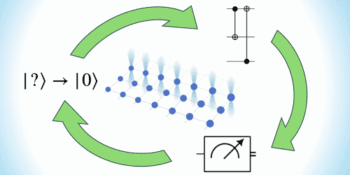
Physicists in the US have created a junction through which single ultracold ions can pass without having their temperature raised. The junction is contained within a 2D ion trap and could be useful in building large-scale quantum computers.
Quantum computers, like classical computers, work by processing of bits of information. In classical computers such bits can take on only the values 0 and 1, but in quantum computers they can also take on “superpositions” of both 0 and 1. When many of these quantum bits or “qubits” are combined, a quantum computer can process them simultaneously. In principle, this would enable a quantum computer to work exponentially faster than its classical counterpart for certain operations — however many technical challenges must be overcome before practical quantum computers become a reality.
Scientists are working on many devices to take on the role of qubits, but one of the most promising are trapped ions. Inside a trap, the position and ordering of the ions could be changed by running them through a junction, at which point they can be encouraged to go in one direction or the other. However, it is important that this switching does not result in any heating, because that tends to take the ions out of the required electronic ground state.
Off the heat
Now, Brad Blakestad and colleagues at the National Institute of Standards and Technology (NIST) in Boulder, Colorado have created a junction in an ion trap in which there is practically no heating. Constructed from laser-machined alumina, it contains 46 gold-coated electrodes surrounding an X-shaped junction. When the researchers apply a series of voltages to the electrodes, ions are encouraged through the junction a little at a time.
The NIST group managed to get ions through the junction with a 99.99% success rate, and with seven orders of magnitude reduced heating than previous trapped ion systems .
Christopher Monroe, a physicist at the University of Maryland in the US who has worked extensively with trapped ion systems, told physicsworld.com that although it is not surprising that the researchers have shuttled ions without losing coherence of their internal states, it is surprising that the ions have not lost any coherence in their motion.
Exquisite control
“Moreover, to shuttle ions around a multitude of electrodes and around corners requires exquisite control of the applied electrical potentials so that the ions surf smoothly without getting lost (or agitated),” Monroe adds. “The NIST experiment accomplishes all of this, and thus marks an important milestone in one of the only known realistic architectures for a large-scale quantum computer.”
Bernhard Roth, a quantum physicist at the Heinrich Heine University of Düsseldorf, Germany, also thinks the work is important. “In particular the work might be relevant toward efficient large-scale quantum information processing, the main challenge in the field,” he says. “The authors have significantly increased the reliability of the ion transport through an array, have reduced energy gain and preserved coherence. These are all things which are considered essential for the realization large-scale systems.”
The research will be published in Physical Review Letters and a preprint of the paper is available on arXiv.



